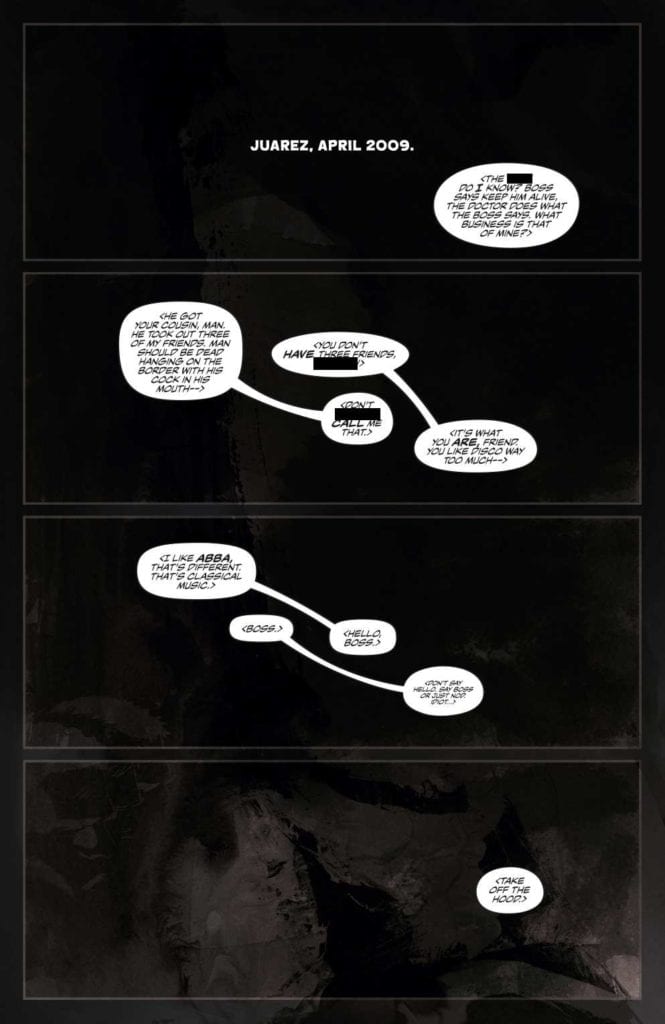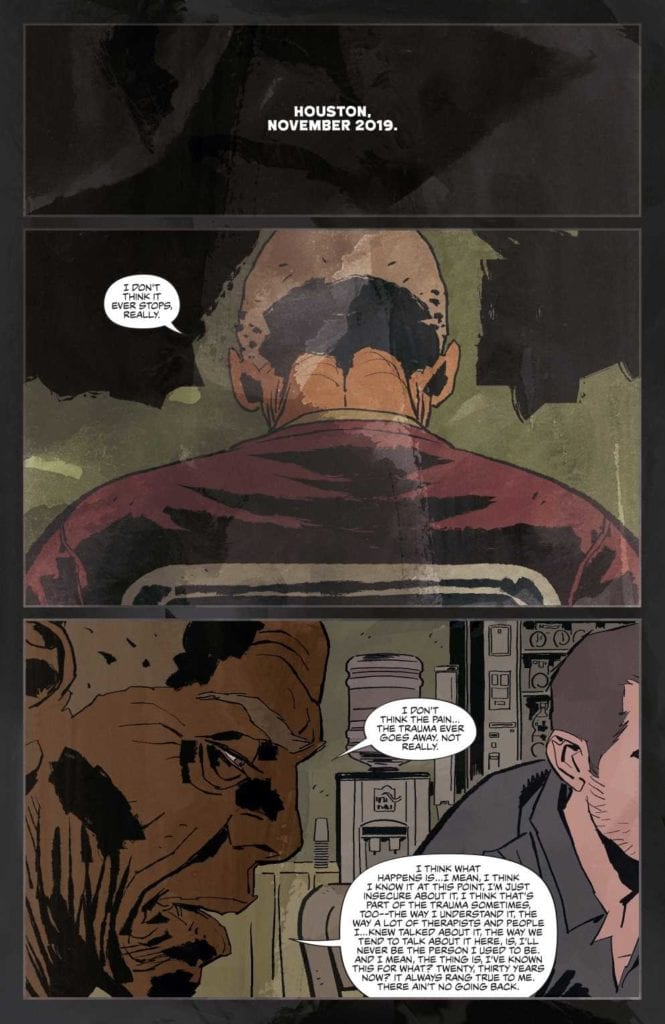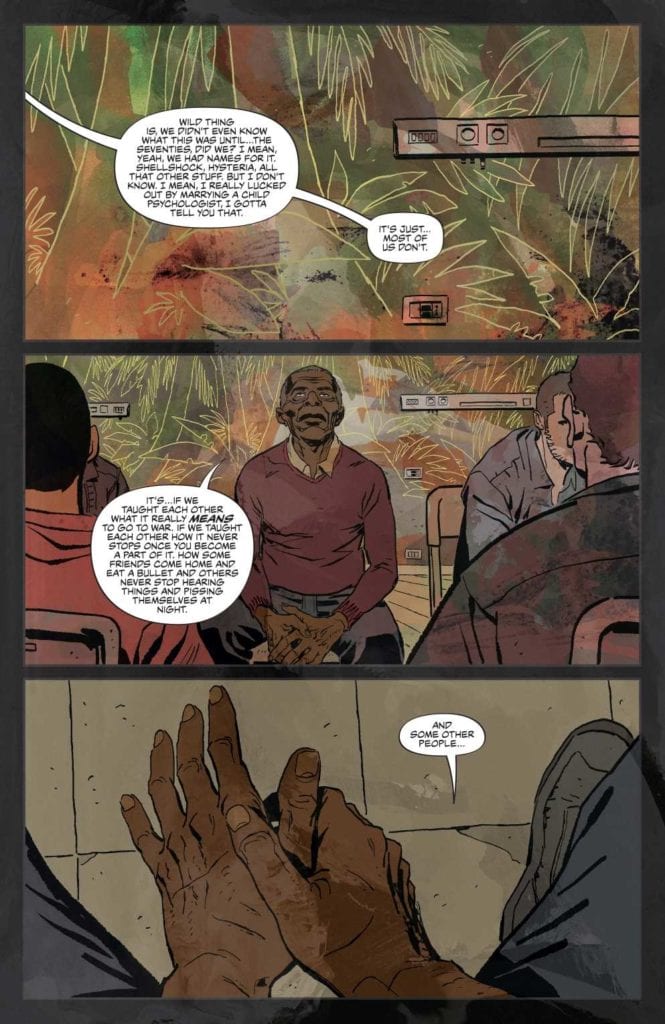Lost Soldiers #5, from Image Comics, completes a powerful mini-series about post-war trauma. Writer Ales Kot shows the ultimate tragedy of connecting with people through traumas. Artist Luca Casalanguida and colorist Heather Marie Lawrence Moore further this feeling with hallucinogenic visuals. Letterer Aditya Bidikar gives each of these moments time to sink in.
Lost Soldiers #5: Breaking Off Intersections
 Kot’s story in Lost Soldiers #5 demonstrates the long term effects of trauma. We no longer follow our unnamed protagonist, who lost his narrative strength in the last issue. Instead, his squad mate Trey takes charge.
Kot’s story in Lost Soldiers #5 demonstrates the long term effects of trauma. We no longer follow our unnamed protagonist, who lost his narrative strength in the last issue. Instead, his squad mate Trey takes charge.
In Trey’s therapy group, he speaks about how lucky he was to avoid the protagonist’s route. Life has been kind to him, thanks to therapeutic sessions he’s attending, unlike the protagonist’s attempts at catharsis. But he feels guilty for failing to connect to the protagonist. Trey and the protagonist had something in common. There was a chance to turn everything around. Instead Trey lied and said he couldn’t hear “the drums”.
Despite this, Kot assures the reader there was a reason Trey backed off. The protagonist is accused of some transgressions against his African American wife and mixed kids. Thanks to some of the uglier aspects of the Vietnam War, like Confederate flag waving, it’s very understandable that Trey kept his distance. This leaves Lost Soldiers #5 with a very melancholic mood that shows how warfare scars people for life.
A Session Across Time And Space
 Casalanguida retains some of the more surreal artwork in Lost Soldiers #5. Shifting between the eyes of Trey and the protagonist, it appears there is a subtle conversation between them. Considering this is between a ten year time gap, it’s almost like Trey is speaking at the protagonists’ funeral.
Casalanguida retains some of the more surreal artwork in Lost Soldiers #5. Shifting between the eyes of Trey and the protagonist, it appears there is a subtle conversation between them. Considering this is between a ten year time gap, it’s almost like Trey is speaking at the protagonists’ funeral.
Then there’s Moore’s colors that bring home the surreal feelings, causing images to look more hallucinogenic. Perhaps the most obvious is the palm tree tapestry in the group therapy room. Considering a chunk of the soldiers in that room are Vietnam veterans, it’s what connects them across time. The protagonist even mentions seeing the tapestry despite not being in the same room.
 Finally, Bidikar does nothing too fancy to bring home the conversations between the characters. Every word balloon feels heavy. It makes the moments in each panel sink in. By slowing down the pacing, the reader feels the weight of the situation. Most of the dialogue happens at the beginning of the page, almost loading the reader up for some emotional whiplash. All of this, and the accompanying visuals, give the reader the feelings of distress throughout.
Finally, Bidikar does nothing too fancy to bring home the conversations between the characters. Every word balloon feels heavy. It makes the moments in each panel sink in. By slowing down the pacing, the reader feels the weight of the situation. Most of the dialogue happens at the beginning of the page, almost loading the reader up for some emotional whiplash. All of this, and the accompanying visuals, give the reader the feelings of distress throughout.
Lost Soldiers #5 Is Complete
Readers will never forget Lost Soldiers #5. The excitement from the action of previous issues will make them feel complicit in the violence. But that’s the point. Communicating across time and reflecting on the decisions made is the essence of trauma. It’s a powerful feeling that readers may have to deal with in real time and make the connection despite the hardships. It’s what makes Lost Soldiers such a powerful series despite the familiar trope of the Shell Shocked Veteran. Because not every soldier fights the same war the same way.

